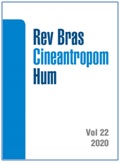“Cross” modalities: are the AMRAP, RFT and EMOM models applicable to health?
Abstract
Currently, training models based on the maximum number of repetitions/rounds or on the execution of a proposed task in the shortest possible time have been gaining ground among Physical Education professionals. However, in our opinion, these models have significant drawbacks that oppose their use in the health context. Thus, we provide an analysis of the problems related to the control and magnitude of the training load (volume and intensity), distribution, duration, and characteristics of the recovery intervals and, of course, the intra-session density. This analysis was made without having measured each of these proposals directly. It is based on the reflection of the dynamics of the efforts made and potential fatigue generated. We hope to be able to verify and provide accurate and reliable data that may support and confirm the hypothesis generated through this analysis.
References
Tibana RA, de Farias DL, Nascimento DC, Da Silva‐Grigoletto ME, Prestes J. Relação da força muscular com o desempenho no levantamento olímpico em praticantes de CrossFit ®. Rev Andal Med Deporte 2018;11(2):84–8.
Tibana RA, de Sousa NMF. Are extreme conditioning programmes effective and safe? A narrative review of high-intensity functional training methods research paradigms and findings. BMJ Open Sport Exerc Med 2018;4(1):e000435.
CrossFit Training. Guia de treinamento de nível 1: Estados Unidos. 2002-2020; Disponível em: http://library.crossfit.com/free/pdf/CFJ_L1_TG_Portuguese.pdf [2020 mai 01].
Tibana R, de Sousa N, Cunha G, Prestes J, Fett C, Gabbett T, et al. Validity of Session Rating perceived Exertion Method for Quantifying Internal Training Load during High-Intensity Functional Training. Sports 2018;6(3):68.
Alsamir Tibana R, Manuel Frade de Sousa N, Prestes J, da Cunha Nascimento D, Ernesto C, Falk Neto JH, et al. Is Perceived Exertion a Useful Indicator of the Metabolic and Cardiovascular Responses to a Metabolic Conditioning Session of Functional Fitness?. Sports 2019;7(7):161.
Hopkins BS, Li D, Svet M, Kesavabhotla K, Dahdaleh NS. CrossFit and rhabdomyolysis: A case series of 11 patients presenting at a single academic institution. J Sci Med Sport 2019;22(7):758–62.
Meyer M, Sundaram S, Schafhalter-Zoppoth I. Exertional and CrossFit-Induced Rhabdomyolysis. Clin J Sport Med 2018;28(6):e92–4.
Tibana R, Sousa N, Cunha G, Prestes J, Navalta J, Voltarelli F. Exertional Rhabdomyolysis after an Extreme Conditioning Competition: A Case Report. Sports 2018;6(2):40.
Mazzetti S, Douglass M, Yocum A, Harber M. Effect of Explosive versus Slow Contractions and Exercise Intensity on Energy Expenditure: Med Sci Sports Exerc 2007;39(8):1291–301.
González-Badillo JJ, Rodríguez-Rosell D, Sánchez-Medina L, Gorostiaga EM, Pareja-Blanco F. Maximal intended velocity training induces greater gains in bench press performance than deliberately slower half-velocity training. Eur J Sport Sci 2014;14(8):772–81.
Heredia Elvar JR, Peña García-Orea G. El entrenamiento de la fuerza para la mejora de la condición física y la salud. Roquetas de Mar, Almería: Círculo rojo; 2019.
Rodríguez-Rosell D, Yáñez-García JM, Torres-Torrelo J, Mora-Custodio R, Marques MC, González-Badillo JJ. Effort Index as a Novel Variable for Monitoring the Level of Effort During Resistance Exercises. J Strength Cond Res 2018;32(8):2139–53.



